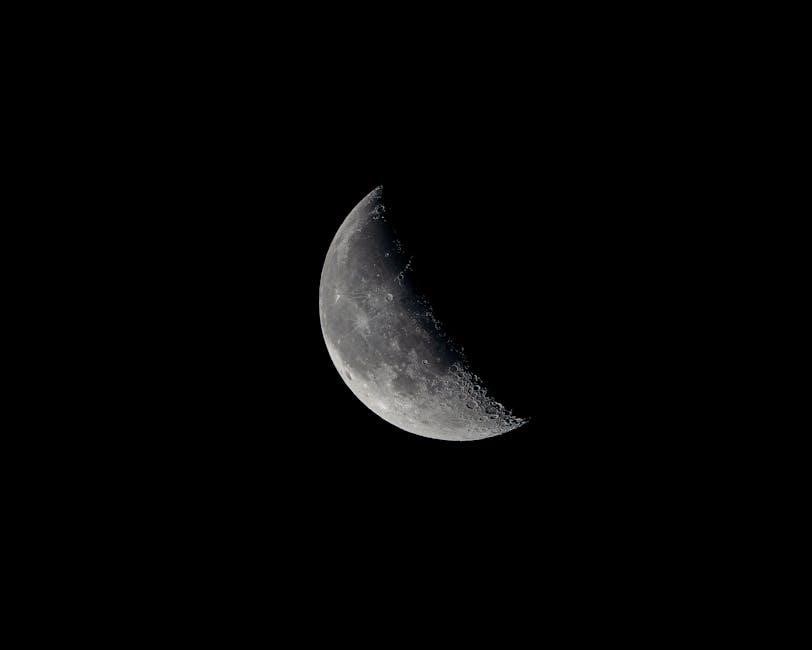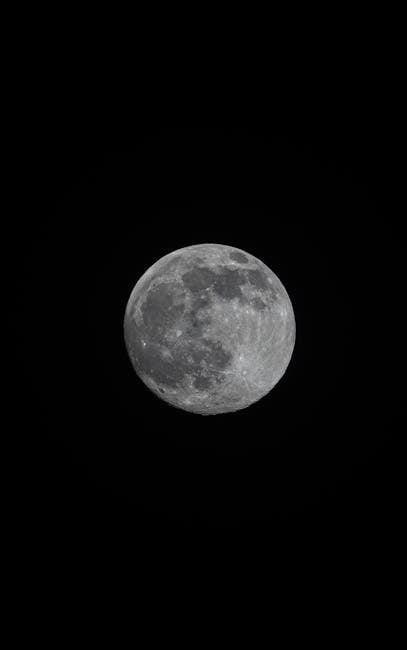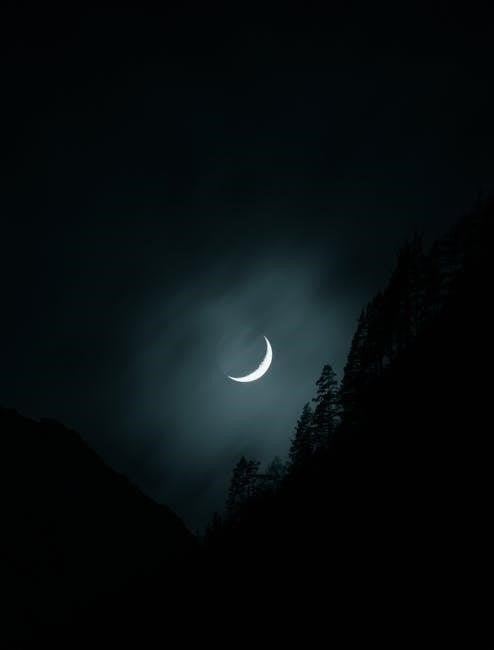The study of moon phases reveals the lunar cycle’s beauty and significance. Understanding these phases helps us appreciate astronomical patterns and their cultural importance. A moon phases PDF guide provides a detailed visual breakdown of each phase, making it easier to track and learn about the moon’s transformations throughout the month.
What Are Moon Phases?
Moon phases describe the varying appearances of the Moon as it orbits the Earth, reflecting different amounts of sunlight. These phases result from the changing angles between the Sun, Earth, and Moon. The primary phases include the New Moon, when the Moon is between the Earth and Sun, and the Full Moon, when the entire face of the Moon is illuminated. Between these are intermediate phases like the Waxing Crescent, First Quarter, Waxing Gibbous, Waning Gibbous, Third Quarter, and Waning Crescent. These phases help track the Moon’s position and predict its behavior. Understanding moon phases is essential for astronomy, navigation, and cultural practices. Resources like moon phases PDFs provide detailed charts and explanations, making it easier to visualize and study these lunar cycles.
Why Study Moon Phases?
Studying moon phases is essential for understanding the lunar cycle and its impact on Earth. Moon phases influence tides, agriculture, and astronomical events, making them vital for navigation and planning. They also hold cultural and historical significance, as many traditions and calendars are based on lunar cycles. By studying moon phases, individuals can gain insights into astronomy, appreciate natural phenomena, and connect with cultural heritage. Moon phases PDFs provide a visual and organized way to track these cycles, making it easier to understand and predict lunar behavior. Whether for educational purposes, personal interest, or practical applications, studying moon phases offers a deeper appreciation of our celestial companion and its role in shaping our world.

The Lunar Cycle Overview
The lunar cycle, lasting about 29.5 days, progresses through New Moon, Waxing Crescent, First Quarter, Waxing Gibbous, Full Moon, Waning Gibbous, Third Quarter, and Waning Crescent before visually completing the cycle.
New Moon
The New Moon marks the beginning of the lunar cycle. During this phase, the side of the Moon facing Earth is completely unilluminated by the Sun, making it invisible from our planet. This occurs when the Moon is positioned between the Sun and Earth, aligning their paths. The New Moon is a symbolic starting point, often associated with new beginnings and renewal in cultural and astronomical contexts. It is followed by the Waxing Crescent phase as the Moon begins to reflect increasing amounts of sunlight. A moon phases PDF guide typically highlights the New Moon as the first stage, providing visual and detailed information about its occurrence and significance in the lunar cycle.
Waxing Crescent
The Waxing Crescent phase occurs after the New Moon, when a small sliver of the Moon’s illuminated surface becomes visible from Earth. This phase is characterized by the Moon appearing to grow larger and brighter as more of its illuminated side faces our planet. The term “waxing” refers to the increasing amount of sunlight reflecting off the Moon’s surface. A moon phases PDF guide often illustrates this phase with detailed diagrams, showing the gradual expansion of light on the Moon’s right side. This phase is typically visible in the western sky shortly after sunset and is a popular time for astronomical observations. The Waxing Crescent symbolizes growth and progress, making it a significant phase in both cultural and lunar studies.
First Quarter
The First Quarter phase marks a significant point in the lunar cycle, occurring when the Moon is half-illuminated from Earth’s perspective. This phase is also known as the “Half Moon” because the terminator—the line separating light and dark—runs vertically across the Moon’s disk. The First Quarter happens approximately 7-8 days after the New Moon and signals the Moon’s continued progression toward full illumination. During this phase, the Moon is visible in the sky for a longer duration, typically rising in the morning and setting at midnight. A moon phases PDF often highlights this phase with detailed imagery, showcasing the stark contrast between the illuminated and dark hemispheres. This phase is particularly important for astronomical observations and is often used in cultural and navigational contexts to track time and plan activities. The First Quarter symbolizes balance and decision-making, making it a focal point in lunar studies.
Waxing Gibbous
The Waxing Gibbous phase occurs after the First Quarter and continues until the Full Moon. During this time, the Moon appears increasingly illuminated from Earth’s perspective, with more than half of its surface visible in sunlight. A moon phases PDF often illustrates this phase with detailed diagrams, showing the gradual expansion of the illuminated area. The Waxing Gibbous phase typically lasts for about 3-4 days, during which the Moon becomes brighter and larger in the sky. It is visible in the eastern sky after sunset and sets in the early morning hours, making it a popular time for lunar observations. This phase is also a great opportunity for photography, as the Moon’s texture and features are clearly visible. The Waxing Gibbous phase symbolizes growth and progress, aligning with its increasing brightness and cultural associations with abundance and preparation.
Full Moon
The Full Moon marks the peak of the lunar cycle, where the entire face of the Moon illuminated by the Sun is visible from Earth. This phase occurs when the Moon is on the opposite side of the Earth from the Sun, typically lasting for about 3 days. A moon phases PDF often highlights this phase with vivid imagery, showing the Moon at its brightest and largest. The Full Moon is a significant event, often associated with cultural celebrations, folklore, and astronomical observations. It is also a time when the Moon’s gravitational pull on Earth’s tides is at its strongest. This phase is ideal for stargazing and photography, as the Moon’s surface details are fully exposed. The Full Moon represents completion and fulfillment, symbolizing the culmination of efforts and the peak of lunar visibility in the night sky.
Waning Gibbous
The Waning Gibbous phase occurs after the Full Moon, when the Moon appears to decrease in size as it moves away from full illumination. This phase is visible in the western sky shortly before sunrise, with the Moon gradually losing light on its right side. The Waning Gibbous phase is a transitional period, marking the Moon’s journey back toward the New Moon. It is a time of reflection and release, often symbolizing letting go of past experiences. A moon phases PDF typically illustrates this phase with detailed diagrams, showing the Moon’s visible light diminishing over time. This phase is also associated with the tides, as the Moon’s gravitational pull continues to influence Earth’s oceans. The Waning Gibbous phase is a reminder of the cyclical nature of life and the constant change in celestial dynamics.
Third Quarter
The Third Quarter phase occurs when the Moon is half-illuminated from the left side, appearing in the western sky at sunrise. This phase marks a pivotal point in the lunar cycle, signaling the transition from the Waning Gibbous to the Waning Crescent phase. The Third Quarter is also referred to as the “Last Quarter” and is a time of reflection and preparation for the upcoming New Moon. A moon phases PDF often highlights this phase with detailed imagery, showing the Moon’s illumination decreasing as it moves through its orbit. This phase is particularly important for navigational purposes and agricultural planning, as it indicates specific tidal patterns and lunar influences. The Third Quarter serves as a reminder of the Moon’s constant transformation and its impact on Earth’s natural rhythms.
Waning Crescent
The Waning Crescent phase occurs as the Moon approaches the end of its lunar cycle, appearing as a thin crescent in the eastern sky before sunrise. This phase follows the Third Quarter and precedes the New Moon. During this time, the illuminated portion of the Moon continues to decrease, eventually becoming invisible from Earth. A moon phases PDF often includes detailed visuals of this phase, showcasing its slender shape and gradual disappearance. The Waning Crescent is a period of transition, symbolizing renewal and preparation for the upcoming cycle. It is a popular subject for lunar photography and is often used in cultural and astronomical studies to track the Moon’s progression. This phase is also significant for tidal patterns and agricultural planning, as it marks the final stages of the Moon’s visible light before it renews its cycle.

Importance and Relevance of Moon Phases
Moon phases hold deep cultural and historical significance, influencing agriculture, navigation, and traditions worldwide. They guide planting cycles, maritime activities, and remain central to many cultural celebrations and beliefs, as seen in moon phases PDF guides.
Cultural and Historical Significance
The study of moon phases has deeply influenced cultures and history worldwide. Ancient civilizations often revered the moon, associating its cycles with deities and mythological stories. For example, the full moon has long been a symbol of celebration, as seen in festivals like the Chinese Mid-Autumn Festival. Many cultures also linked the lunar cycle to agricultural practices, timing planting and harvesting with specific moon phases. Additionally, the moon’s phases have inspired art, literature, and spirituality, becoming a timeless muse for human creativity. Historical records show that early societies used the lunar cycle to track time, creating calendars that aligned with the moon’s transformations. This cultural significance continues to resonate today, with many people using moon phase PDF guides to connect with these ancient traditions and appreciate the moon’s enduring influence on human life and culture.
Agricultural and Navigational Uses
Moon phases have long been a vital tool for agriculture and navigation. Farmers historically planted and harvested crops based on the lunar cycle, believing that the moon’s gravitational pull influenced soil moisture and plant growth. The new moon and full moon phases were often considered ideal for planting and harvesting, respectively. Similarly, sailors and fishermen relied on moon phases to predict tides, using the waxing and waning moon to determine high and low water levels. This knowledge was crucial for safe navigation and successful fishing trips. Today, a moon phases PDF can serve as a practical guide for modern farmers and sailors, offering a visual and detailed breakdown of the lunar cycle to aid in planning and decision-making. This timeless connection between the moon and human activities remains a cornerstone of traditional practices.

Resources for Moon Phase Information
Moon phase PDFs are widely available, offering detailed visual breakdowns of the lunar cycle; These resources are ideal for tracking, planning, and educational purposes, providing clear, organized information.
Moon Phase PDFs
Moon phase PDFs are comprehensive guides that visually illustrate the lunar cycle, making it easy to track and understand the moon’s transformations. These documents often include detailed charts, calendars, and explanations of each phase, from the new moon to the waning crescent. Many PDFs are designed for educational purposes, providing clear visuals and descriptions that help learners grasp astronomical concepts. They are also useful for planning activities like gardening, fishing, or astronomical observations, as they offer precise timing and phase information. Some moon phase PDFs are customizable, allowing users to input specific dates or locations for personalized tracking. Their portability and accessibility make them a popular resource for both enthusiasts and educators. Additionally, these PDFs often include historical and cultural insights, enriching the user’s understanding of the moon’s significance. Overall, moon phase PDFs are versatile tools that combine functionality with educational value, catering to a wide range of interests and needs.
Moon Phase Apps and Tools
Moon phase apps and tools offer interactive and dynamic ways to explore the lunar cycle. These applications provide real-time updates on the current moon phase, moonrise and moonset times, and upcoming lunar events. Many apps feature detailed simulations, allowing users to visualize the moon’s position and phase changes. Some popular tools include moon phase calculators, lunar calendars, and augmented reality apps that overlay the moon’s phase on the night sky. These tools are particularly useful for astronomers, photographers, and anyone interested in tracking the moon’s cycles. They often include notifications for key events like full moons, eclipses, and supermoons, making it easier to stay connected to celestial happenings. With their accuracy and user-friendly interfaces, moon phase apps are invaluable for both casual enthusiasts and professional skywatchers. They complement moon phase PDFs by offering a more interactive and updated experience for lunar exploration.

Tracking Moon Phases
Tracking moon phases is simplified with apps, PDF guides, and lunar calendars. These tools offer real-time updates and detailed simulations, helping enthusiasts plan observations and stay informed about celestial events.
How to Observe Moon Phases
Observing moon phases is a fascinating activity that combines astronomy with personal curiosity. To begin, use a moon phases PDF guide or app to track the lunar cycle. Find a clear, dark location with minimal light pollution for optimal viewing. Binoculars or a telescope can enhance your experience, especially during crescent or gibbous phases. Photographers can capture stunning images by using a tripod and adjusting camera settings for low light. Timing is crucial—view the moon at sunrise or sunset for the best visibility. Keep a journal to record your observations, noting the date, phase, and any notable features. Moon phase calendars or apps can help you plan observations and stay updated on rare events like eclipses or supermoons. Consistency is key to fully appreciating the moon’s ever-changing beauty.
Photography Tips for Moon Phases
Capturing the beauty of moon phases requires careful planning and technique. Use a tripod to stabilize your camera, ensuring sharp images even in low light. A telephoto lens (at least 200mm) is ideal for detailed shots. Shoot during the golden hour or twilight for dramatic skies. Manual focus is recommended to avoid autofocus issues. Use RAW format to preserve image detail. Experiment with ISO settings (start with 800-1600) and adjust shutter speed based on brightness. Include foreground elements like landscapes for context. Edit photos using software to enhance contrast and clarity. Refer to a moon phases PDF for timing and phase predictions. Practice patience, as the best shots often require waiting for optimal conditions. Consistency will help you build a stunning portfolio of lunar imagery.

Rare Lunar Events
Rare lunar events include total eclipses and supermoons, offering breathtaking views. These phenomena occur when Earth, Moon, and Sun align uniquely, creating unforgettable spectacles. A moon phases PDF highlights predictions for such events, aiding enthusiasts in planning observations and photography.
Lunar Eclipses
A lunar eclipse occurs when Earth blocks sunlight from reaching the Moon, casting a shadow. There are three types: total, partial, and penumbral, each offering unique visual experiences. Total eclipses, the rarest, create a “Blood Moon” due to Earth’s atmosphere scattering red light. These events are significant for astronomers and enthusiasts alike, often sparking cultural and scientific interest. Lunar eclipses are relatively rare because the Moon’s orbit is tilted, making precise alignments uncommon. They are visible from entire hemispheres, making them accessible for global observation. A Moon phases PDF provides detailed predictions, timing, and visibility maps for upcoming eclipses, helping observers plan. These resources also explain the science behind eclipses, enhancing understanding and appreciation for these celestial phenomena. Eclipses are fleeting, lasting a few hours, but their beauty and rarity make them unforgettable astronomical events.
Supermoons and Other Rare Phenomena
A supermoon occurs when the Moon is at its closest point to Earth, appearing larger and brighter. This phenomenon happens during a new or full moon, amplifying tidal forces and creating striking visual effects. Supermoons are classified into types: New, Full, and rare combinations like a “Blood Supermoon” during a total lunar eclipse or a “Blue Supermoon” when two full moons occur in one month. Other rare events include lunar halos and penumbral eclipses, which captivate astronomers and enthusiasts. These phenomena are eagerly anticipated and documented, offering unique opportunities for observation and photography. A Moon phases PDF guide often highlights these events, providing dates, times, and viewing tips to help enthusiasts make the most of these celestial spectacles. Supermoons and rare lunar phenomena remind us of the Moon’s dynamic and awe-inspiring nature. Observing them fosters a deeper connection to our universe’s rhythms and beauty.
